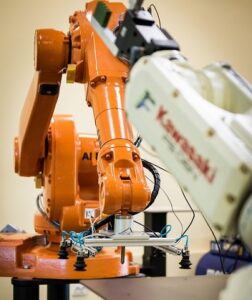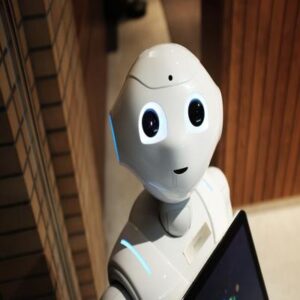Automation
Introduction
With the ever-increasing demand for various products and services, it has become very difficult for an organization to meet the needs. Most importantly, it should meet various industrial quality standards and produce at a competitive rate. To meet such challenges, automation plays a significant role. Today with the advancement of science and technology, automation can be found in various industrial verticals like manufacturing, production, healthcare, banking, R&D, logistics, etc.
Automation has advanced the human skills and resources for greater capabilities, greater efficiency and so forth. Now, the tasks which were beyond human reach can be automated. With the help of automation, an organization can achieve productivity, profitability and quality. Due to the advancement in the field of Data Science, the future of automation looks promising.

What is Industrial Automation?
Automation is a technology of automatically execution of a process or a procedure by the use of advanced software and systems. It performed tasks with minimal human intervention. With a simple command or a press of a button, it will execute to attain a specified set of targets. With the integration of automation in an organization, it reduces time, human labour, errors & complications, increases productivity, improves quality and much more.
General examples of automation are
Elevator – With one click at a button, we reach different floors within seconds. If we have to go to the tenth floor, how long it will take to reach there – a minimum of ten mins. But with the help of a lift, we reach within seconds.
Chatbots – With the help of chatbots, organization are engaging their customers by providing support and services. Evolution of Artificial Intelligence and Machine Learning has upgraded chatbots in a more impactful way. Its applications can be found in many areas like banking, e-commerce, healthcare, airlines, media, etc.
To trace the evolution of automation, we have to first look the early days where the development of tools like wheel, lever and pulley were used by different sections of people in their work activities. Gradually, development began in all aspects. Some of the major inventions in the field of automation during the eighteenth & nineteenth century were
- Windmills – Edmund Lee in 1745
- Automated Loom – Jacques de Vaucanson in 1745
- Automated Spinning – Richard Arkwright in 1771
- Steam engine – James Watt in 1776
- Automated Flour will – Oliver Evans in 1785
- Telegraph – Samuel F.B. Morse in 1836
- Sewing machine – Elias Howe in 1844
- Analytical Engine (concept of programming a machine) – Charles Babbage in 1833 – 1871
- Telephone – Alexander Graham Bell in 1876
- Induction electric motor – Nikola Tesla in 1888
However, the time period when automation has significant developments was during the twentieth century.
During the 1910s, Ford Motor introduced an assembly line which reduced the assembly time from twelve hours to about one and a half hours per car which leads to mass production and a huge margin of profits were gained. During the 1920s and 1930s, electricity played a huge role in industrial automation and productivity was increased tenfold.
After the second world war, Japan developed gradually and became the world leader in industrial automation. During this period, automatic devices and controls in mechanized production lines were widely used.
The term “Automation” was coined in 1947 by D.S Harder, an engineer from Ford Motor Company. It was during this time there was a rapid rise of industrial automation in the automobile industry. The term was widely used in a manufacturing point of view, but it was also applied on non – manufacturing sectors. Other significant developments were in the field of computer and software, data-storage, control systems, advances in sensor technology and so forth.
Over the years, we have grown our attachment towards automated technology. It’s found in almost every part of our lives, from automatic lift to robotics in manufacturing floors, to service and business processes automation. With the advancement in the field of science & technology, automation has further enhanced in various major developments. Robotics and data science have completely changed the face of automation. Today, automated machines are doing tasks with minimal human intervention and have enhanced workforce capabilities. Manufacturing floors are automated and robots would handle the entire process. Robots can be seen doing various tasks in the service industry like banks, hospitals, R&D, tourism and so on.
Fixed Automation – Also known as Hard Automation. Here, equipments are used to automate the process or assembly operations in an orderly sequence. This type of automation is usually simple, applicable in mass production systems and are used to perform a repetitive set of operations. The equipment has a fixed – repetitive sequence of operations and utilized in continuous systems like assembling process, chemical process, refining process, etc. All these processes depend on automated machinery to perform their fixed and repetitive set of operations. During the process, it is difficult to change or undo the set of operations. Therefore, it is known as Hard Automation. It is usually a high investment process.
Some of the features are
- Higher production rate
- Reduces unit cost
- Automated process
- Consistency output
Programmable Automation – As the name suggests, the whole set of operations are controlled by a program and are suited for a process where production volume is medium to high. Here, a set of operations or design configuration can be changed with the modification in a program and more developed than Hard Automation. The operation processes are controlled by a coded instruction (program) which allows the devices or equipment to read and interpret them. New programs can be coded for the new process or products design. Some of the features that differentiate it from hard automation are the capability to adapt to changes, low production rate and so forth. Few examples of Programmable Automation are robots, controlled machines, computer-integrated manufacturing, etc.
Some of the features are
- Capability to adapt with changes
- Higher production rate
- Low unit costs
- Consistency output
Flexible Automation – Flexible Automation is an advanced level of Programmable Automation. It has a flexibility of adopting changes in various product designs or processes and takes less time than Programmable Automation. Each set of operation are done automatically and are followed by high-level programming codes. Unlike Programmable Automation, here we can make changes w.r.t multiple designs and parameters in the process with no loss of time. In another way, we can say that there is no loss of time while reprogramming the codes for different parameters or settings. Comparatively, it is more costly than the other types of automation. Few examples are industrial robots, material handling systems, etc.
Some of the features are
- Flexibility to deal with various changes
- Greater efficiency
- Reduces cost
- Continuous process flow
Hardware Robot – Robot is a mechanical device capable of doing complex work and is programmed with specific coded instructions. We can find its applications in various areas like retail & sales, banking, telecom, manufacturing, healthcare and so on. Its usage is commonly found in various types of Industrial Automation.
Some of the examples are automotive industry robots, self-driving robot, medical robot, etc.
Benefits
- Consistency output
- Higher Production rate
- Low unit costs
- Improve operational efficiency
Software Robot – Commonly known as bots. Software Robot is a set of coded instructions which runs on a host device and fully enabled by the AI system. We can find its applications in various areas like retail & sales, banking, telecom, manufacturing, healthcare and so on.
Some of the examples are virtual assistants (Siri, Alexa), chatbots, email filtering, etc.
Benefits
- Customer satisfaction
- Automated Responses
- Accuracy
- Reduced costs
Automation in the Manufacturing sector
Today, due to high competition in the market and with growing demands of high-quality products – every organization has to compete with each other. Customers have the best option to choose from the alternatives available to them. Moreover, the organization should manufacture products on a high production rate with consistent quality. To overcome these challenges, organization are taking advantage of industrial automation. With the help of automation technologies, manufacturing industries are able to save time, increase productivity, low unit costs, consistent and reliable product quality, elimination of human error, etc. We can see its applications in various manufacturing domains like automobile, electrical, aerospace, pharmaceuticals, beverage and so on.
Some of the applications are
- Material Handling
- Packaging & Filling
- Process monitoring
- Quality Control
- Data Management

Automation in the Service sector
While in the manufacturing sector, automation has a dominant presence and in the service sector, it has also started to show its presence. In the service industry, automation is playing a key role in engaging customers and giving more priority to them. We can see automation applications in various verticals like banking & financial services, telecom, healthcare, logistics, hotels, fast food, airlines and so on. With the help of automation technologies, service industries are able to save time, improve efficiency, reduce operating costs, improve customer satisfaction rates, etc. Common examples are ATM, kiosk systems, chatbots, email automation, etc.
Some of the applications are
- Automated Responses
- Consulting services
- Data management
- Decision – making

- Increase productivity
- Reduce costs & save time
- High-quality products and services
- Elimination of human error
- Improve operational efficiency
- Automated customer support
- Enhance safety measures
- Achieve customer satisfaction
#